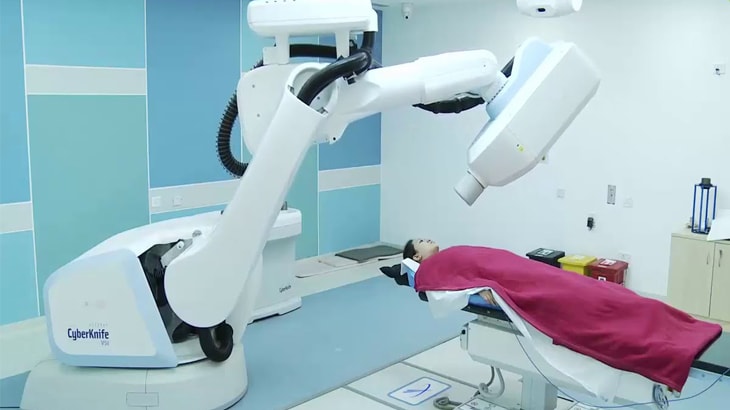Cyberknife Treatment Cost in India
- CyberKnife is a radiation therapy used as a non-invasive treatment for cancerous tumors anywhere in the body and the cost of CyberKnife in India is USD 6500 to USD 8000.
- It delivers radiation directly to the cancerous tissue thus fewer side effects and higher success rates.
- It is an out-patient treatment and is undertaken in 1 to 6 sessions.
- Tests required for determining the size, shape and location of the tumor are CT Scan, MRI, Angiography and PET.

What is Cyberknife?
CyberKnife is an exact, painless, and noninvasive radiation therapy which could be a substitute for radiotherapy or to open operation in some specific scenarios.
Throughout the Cyberknife radiosurgery process, the tumor receives a cumulative dose of radiation to either restrain or destroy the tumor cells while radiation exposure to surrounding tissue is minimized. The Cyberknife can compensate for patient movement to guarantee highly precise delivery of radiation during therapy.
When patient motion happens during therapy, the cameras detect the position shift, along with the robot can compensate for the motion by hammering the LINAC before administering the radiation beam. This practice of correcting for beam replacement guarantees true tumor targeting.
Understanding the Mechanism
The exceptional mechanism of this Cyberknife supplies a noninvasive, surgical-like result for lesions of the spine and brain. It’s the first and only industrial use of autonomous stereotactic radiosurgery for the spine and the spinal cord. Moreover, this technology has the advantage of allowing the Cyberknife platform to be utilized for radiosurgical programs away from the mind as was for staged radiosurgical procedures.
Cyberknife radiosurgery has also been effectively utilized to treat chosen lung malignancies. The combo of both investigational hardware and software using Cyberknife technology can provide conformal radiation into transferring primary and metastatic lung tumors if the operation isn’t an alternative. The Cyberknife accommodates lung and tumor movement, enabling alterations to be made in order to deliver a maximum therapeutic dose when minimizing surrounding tissue degeneration.
Cyberknife Disease Treatment
The Cyberknife intervention is a superb assistance to patients that are handling deadly tumors. Cyberknife can be used to deal with:
- Non-Cancerous Tumours
- Brain Cancer
- Prostate Cancer
- Liver Cancer
- Cancerous Spine Tumours
- Esophageal cancer
- Head and Neck Cancer
- Breast Cancer
Benefits of CyberKnife
Non-Surgical Procedure
CyberKnife is a non-surgical procedure that targets cancerous cells with its radiation beams that prevent them from multiplying or spreading in the body, gradually killing them.Faster Results
The radiation beams used in this therapy are twice more powerful than radiation therapy that helps in killing the cancerous cells within two to five therapy appointments.High Accuracy
Unlike surgery or radiation therapy, the precision used in this system is 40 times more accurate.Faster Recovery
CyberKnife is a non-invasive procedure which treats the patient using radiations, without making an incision on his/her body. This automatically helps in speedier recovery as the patient doesn’t have to wait for his/her surgical wounds to heal.Limited Risk
Unlike surgery, chemotherapy and radiation therapy, CyberKnife radiosurgery has limited risk, that fade away within a few weeks after the operation allowing the patient to go back to their usual routine.Flexibility
CyberKnife system comes with a robotic maneuverability that can be used to deliver highly individualized treatments by the doctors. CyberKnife is a robotic arm that provides unlimited flexibility to the doctors. CyberKnife makes it possible for doctors to target a tumour in any part of the body, from any conceivable angle.During Cyberknife Procedure
After patients have been assessed and assessed by the multidisciplinary team, the treatment procedure starts. The Procedure involves the following three measures:
Treatment Delivery
Each one of these procedures can happen either on precisely the exact same day or on different visits. Unlike traditional stereotactic radiosurgery, the Cyberknife treatment preparation process doesn’t require the patient to be restricted within an acute care environment while the program is devised. Patients can come home in between therapy planning appointments.
Treatment Setup
During therapy installation, the group intends the overall specifics of radiation shipping. If a tumor has been treated, then a custom-fit plastic mask is created for your individual. The individual has a CT scan using iodinated dye comparison with the mask in place. The CT information is subsequently incorporated into the treatment planning applications and reconstructed demonstrating various patient places are connected with pictures of the goal so the computer could identify from three-dimensional distance precisely in which the lesion is situated.
Treatment Planning
Cyberknife treatment planning uses the clinical expertise of the radiation oncologist as well as the physicist in addition to the ability of high-speed computers to ascertain the quantity, dose and pattern of radiation ray goal. During the preparation phase, the Cyberknife performs numerous calculations to ascertain the best radiation delivery programs.
Treatment Delivery
Shortly after therapy preparation is finished, the patient returns for therapy delivery. During therapy, the patient lies face upward on the treatment table and can be fitted with the right immobilization device. At the start of the true therapy, the imaging program accelerates digital x-rays of tumor localization and patient position. This information is sent to the arm, which can be used to maneuver the LINAC into the Suitable positionSince the treatment continues, the robot goes and retargets the LINAC at several different places around the individual. At every place, a little radiation beam is delivered. This procedure is replicated at 50-300 distinct places around the individual to finish therapy.
Cyberknife Treatment Limitations and Risks
- One of the largest constraints of Cyberknife is the elongated shipping period for patients.
- Short-term unwanted effects include nausea, fatigue, and hassle
Factors Affecting the Cost of Cyberknife Treatment
Some of the following factors may affect your cost of treatment:
- The hospital you opt for
- Type of room – Standard single room, deluxe room, super deluxe room for the number of nights specified (including nursing fee, meals, room rate, and room service).
- Operating room, ICU
- Fee for the team of doctors (Surgeons, Anaesthetist, Physiotherapist, Dietician)
Medicines involved - Standard test and diagnostic procedures
Medicare Spots offers the best Cyberknife Treatment Cost in India at an affordable price for international patients coming to India under the supervision of the most trained doctors.
Frequently Asked Questions about CyberKnife Treatment
Q. Is CyberKnife Painful?
A. No, CyberKnife is a non-invasive radiosurgery treatment that doesn’t require any surgical incisions. It uses powerful radiation beams that meticulously target the abnormal or cancerous cells only, without affecting the healthy blood cells.
Q. How successful is CyberKnife?
A. CyberKnife is the fastest way of curing cancer available in the medical world today, which uses less radiation, and has fewer risk factors than other traditional treatment like surgery and radiation therapy. As of now, the research shows that CyberKnife has a success rate of almost 100 per cent.
Q: What is Cyberknife Radiosurgery?
A: Cyberknife Radiosurgery uses focused beams of intense energy to destroy cancer cells and shrink or control the growth of tumours. Radiosurgery works by preventing targeted cells from multiplying. The objective of Radiosurgery is to destroy the harmful cells while minimizing damge to healthy cells. Cyberknife Radiosurgery may be recommended as an alternative to surgery or in addition to surgery or other therapies. It also can be used to manage pain caused by lesions.
Click here to know more about Cyberknife
Q: How long does the Cyberknife Radiosurgery usually take?
A: Cyberknife Radiosurgery normally last between 30-90 minutes. The time-span of a CyberKnife treatment session is mainly dependent on the number of beams used to treat the tumour and the degree of motion exhibited by the target. In most cases, tumours can be treated within three treatments, usually on consecutive days and it is rare for a treatment to extend beyond one week.
Q: Do I need Cyberknife Treatment?
A: Cyberknife is a fairly new non-invasive procedure that replaces surgery and other Radiotherapies to treats tumours anywhere in the body. Since it is non-invasive, it doesn’t involve anesthesia or any blood, with very little recuperative time. If you want to find out if Cyberknife treatment is right for you, consult your doctor or call a Cyberknife specialist.
Q: How much time will it take to see results?
A: Most Stereotactic Body Radiation Therapy (SBRT), including CyberKnife radiosurgery, are usually delivered in 1-5 sessions and take about a week to complete. Keep in mind that the time frame varies between patients and between types of treatment. For instance, neurosurgical treatments like trigeminal neuralgia will see results almost immediately.
Q: What are the side-effects of Cyberknife?
A: The recuperative time-frame for Cyberknife is generally very little. Patients in general, experience very little to no side-effects. Some patients experience nausea and fatigue, nevertheless the cyberknife physician will explain all potential side-effects before the start of the treatment.
Q: Are there any risks associated while travelling?
A: It is best to consult your doctor for advice on travelling pre or post Cyberknife treatment. However, in most cases there is no difficulty in flying before or after the treatment. We come across a large number of patients who travel for Cyberknife treatment in India, stay for a couple of weeks and return to their home countries without any complications.
Q: How is Cyberknife different from other traditional forms of Radiotherapy?
A: There are a number of similarities between Cyberknife and traditional forms of Radiotherapy that uses beams of X-rays to destroy the DNA inside tumour cells. However, in the case of Cyberknife the X-ray beams are finer and more powerful. This allows them to sculpt much more accurately to the shape of the tumour.This unique ability of Cyberknife, means that they can be used to destroy complex or otherwise inaccessible tumours, which would otherwise not be possible with other forms of Radiotherapy.
Q: Can I go for Cyberknife Treatment while undergoing Chemotherapy?
A: Patients currently undergoing Chemotherapy or have undergone Chemotherapy in the past can be treated with Cyberknife. It is important to state complete patient history with respective doctor before the treatment commences.
Best Hospital for Cyberknife Treatment in India

Medanta Hospital

Artemis Hospital

